Do I need to file a tax return? What to expect for refunds this year? If you are driving for business purposes then you may be qualified to deduct your expenses for reimbursement. Same, if you are a business owner who assigned an employee to drive your vehicle for work errands. You need to record everything, both personal and business driving, so it is more accurate, fast, and organized when in need of computation. However, personal driving is not deductible. You can use an online mileage log maker for effortless driving log management. Here, you can learn how to log your business mileage for taxes:

- Qualifications for Mileage Deduction
You can deduct mileage for driving as long as they are business-related errands. You can check on Claiming Your Business Mileage Deductions to what are the acceptable business purposes to qualify.
- Choose Method in Calculating Mileage Deductions
A taxpayer has two options:
- Actual expenses method – it requires you to save all receipts and other supporting documents about the costs of driving.
- Standard mileage method – it requires you to keep a track of your mileage.
You can check Tips on Calculating Mileage Deductions on how to compute each method and which one is the best to utilize.
- Record Your Vehicle’s Odometer
The IRS requires taxpayers to disclose the total number of miles driven by their car during the tax year. The total mileage number must be indicated on Form 2106. At the beginning of the tax year, you should record the vehicle’s odometer. However, if the car is not brand new and was purchased during the year, take note of the odometer reading from the first day you used it.
- Keep a Driving Log
If you want to utilize the standard mileage deduction, you must track your driving business mileage. The IRS requires that at the start of each travel you need to record the following:
- Time and date of the drive
- Starting point
- Destination or place of the drive
- The business purpose of the drive
- The total distance drove or odometer readings

- Keep Relevant Receipts & Documents
The mileage log is not required if you use the actual expense deduction. Storing your receipts and other supporting documents is a must. Each record must include the following:
- the date
- amount paid for the service or product
- description of the product or service needed
- Track Odometer at the End of the Tax Year
You need to record your ending odometer reading after the tax year. The odometer reading at the beginning and the end will be used to compute the total miles driven in the car for the year. The percentage of miles driven for business purposes is also required to declare on Form 2106.
- Track Mileage on Tax Return
When filing your taxes, you’ll enter the total number of miles driven on Form 2106, Line 12 (Total miles the vehicle was driven during 2020). The dollar deductible amount is determined by multiplying this figure by the standard mileage rate for the year. If you use the actual expenses method, you must categorize your receipts for expenses such as:
- rental, and insurance payments
- vehicle registration or inspection fees
- regular maintenance and repairs
- new vehicle parts expenses
- depreciation expense
- Keep the Documentation
Your documents relating to mileage deduction must be kept for at least three years. If the IRS requests proof to prove the mileage deduction, you should make a copy and file a personal copy. Make a new log for each tax year to keep track of everything.




